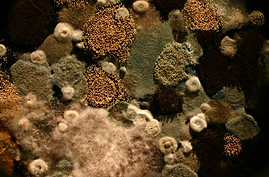Commercial Indoor Air Quality
Three Critical IAQ Elements
Airborne Chemicals

Airborne chemicals are often described using the term "TVOC" (Total Volatile Organic Compounds).
TVOC's can be emitted from such items as; paint, glue, varnish, furniture, cleaning products, carpets, vehicle exhausts, air fresheners plus a host of other methods.
Currently, there are over 1,000 different members of the VOC family with some of the more well-known pollutants being; formaldehyde, benzene and methylene chloride.
A number of TVOC's are known carcinogens which also are a major cause of allergens and asthma symptoms.
Airborne Particles

Commonly known as suspended particulates, airborne particles can have a devastating effect on susceptible people's respiratory systems - especially individuals who suffer from asthma and allergies.
Particulate is measured using the micron scale with PM2.5 (2.5 microns) being particularly harmful to sufferers of allergies and asthma.
Declared by the WHO (World Health Organisation) as a Group 1 Carcinogen due to their ability to penetrate deep into the lungs and bloodstream, particulates can cause permanent DNA mutation, heart attacks and premature death.
Airborne Bacteria & Mold

Micro-organisms are another potential source of indoor air pollution. The three main types of microbiological contaminants are; bacteria, fungi (molds and yeasts) and viruses. All of these airborne contaminants are more readily spread in areas of high humidity.
Tuberculosis (TB) is extremely contagious via airborne dispersal and molds are almost certain to grow where humidity levels are at, or higher than, 70%.
Mold spores can live for many months and cause harm to humans and also damage to expensive items of furnishing, wood, carpets, silk and other organic, porous materials.
Indoor air quality (IAQ) problems are not limited to homes. In fact, many buildings have significant air pollution sources. Some of these buildings may be inadequately ventilated. For example, mechanical ventilation systems may not be designed or operated to provide adequate amounts of outdoor air.
Also, people generally have less control over the indoor environment in offices and public places than they do in their homes. As a result, there has been an increase in the incidence of reported health problems.
Even though your Indoor Air Quality may seem fine, it is essential that ALL the parameters which make-up the air you are breathing are assessed.
We regularly find that our clients only take notice of the thermostats in their buildings as a judge of air quality. In addition to the temperature, your thermal comfort is affected by Relative Humidity and the much-forgotten Dew Point of the air that surrounds you.
Incorrect Thermal Comfort levels not only affect building occupants comfort but can also encourage mold and mildew growth if not controlled.
Also, harmful chemicals (TVOCs - Total Volatile Organic Compounds) may easily be unnoticed unless checked.
Clean Air’s IAQaudit takes into account nine different indoor air quality parameters when conducting an assessment, as follows:
-
TVOCs
-
Relative Humidity
-
Ozone
-
Formaldehyde
-
Carbon Dioxide
-
Carbon Monoxide
-
Temperature
-
Electro Magnetic Fields
-
Suspended Particulate
-
LUX Lighting
-
Airborne Bacteria
Yes.
We have helped large hotels with 500+ rooms significantly reduce their energy costs directly by performing an IAQaudit.
Standard building codes determine that a certain amount of fresh air is brought into any building. However, if the outside ‘fresh’ air is 30+ degrees Celcius with 90%+ humidity levels, this is obviously not the best scenario for any building facilities manager to work with.
By reducing the fresh air intake, and assessing the impact of this on other parameters (TVOCs, Carbon Dioxide etc) we have been able to help large building owners make substantial savings while maintaining clean, healthy indoor air.
Not only does reducing humid, hot air from entering a building directly save money on HVAC system costs, it will also protect expensive fixtures and furnishings from damage caused by damp and humidity.
Lastly, after the IAQaudit we have been told that staff and guest complaints relating to previous indoor air quality issues fall significantly.
Many allergies and health issues brought on by poor indoor air quality can be reduced or even eradicated by acting upon the results of an IAQaudit.
Why Test the Air?
Will an IAQ Audit Save Me Money?

Sectors that benefit from our IAQ service

Factories & Industrial
Indoor Air Quality (IAQ) should be an essential component of any Health & Safety program in industrial or factory-type premises.
Being able to identify the presence of toxic or poisonous gases could save lives!

Office Environments
Poor indoor air quality can be making your staff under-perform resulting in much lower productivity and attention to the task in hand.
Staff and visitor comfort is an integral part of providing a happy office environment.

Schools & Kindergardens
The risk of allergies and asthma can be much higher in classrooms. Smaller people's lungs can be susceptible to pollutants present in the air being breathed.
It is vital to check that paints and glues being used around children are safe!

Hospitals & Medical
It should go without saying that the air being breathed by medical patients should be as clean and free of pollutants as possible.
Cancer patients, with low immunity, are especially at risk.

Hotels & Hospitality
Such things as smoking in undesignated areas and the bringing in of poor air from outside can contribute to hotel guest complaints.
Frequent IAQ testing can greatly enhance the hotel guest experience.

Air Conditioning Engineers
An IAQ test is the best method of making sure any HVAC system is 'in balance' and functioning efficiently.
A recent one-day IAQ saved a large hotel over THB1m per year in HVAC costs!
